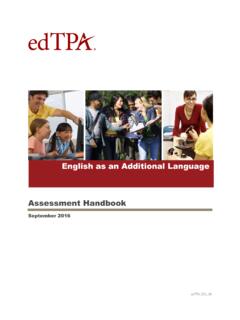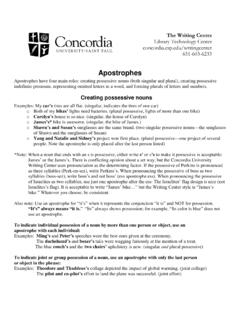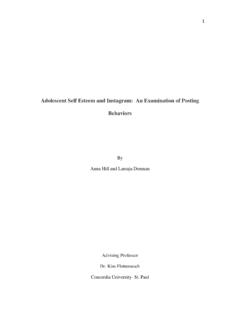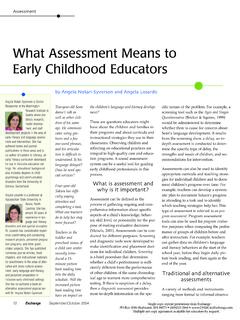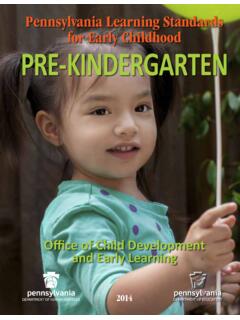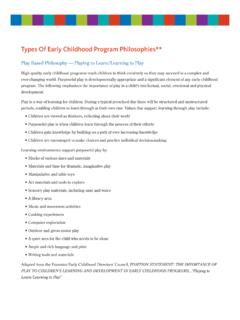Transcription of Early Childhood Assessment Handbook
1 Early ChildhoodAssessment HandbookSeptember 2016 edTPA_EC_05 edTPA Early Childhood Assessment Handbook edTPA stems from a twenty-five-year history of developing performance-based assessments of teaching quality and effectiveness. The Teacher Performance Assessment Consortium (Stanford and AACTE) acknowledges the National Board for Professional Teaching Standards, the Interstate Teacher Assessment and Support Consortium, and the Performance Assessment for California Teachers for their pioneering work using discipline-specific portfolio assessments to evaluate teaching quality.
2 This version of the Handbook has been developed with thoughtful input from over six hundred teachers and teacher educators representing various national design teams, national subject matter organizations (ACEI, ACTFL, AMLE, CEC, IRA, NAEYC, NAGC, NCSS, NCTE, NCTM, NSTA, SHAPE America), and content validation reviewers. All contributions are recognized and appreciated. This document was authored by the Stanford Center for Assessment , Learning, and Equity (SCALE) with editorial and design assistance from Evaluation Systems.
3 Copyright 2016 Board of Trustees of the Leland Stanford Junior University. All rights reserved. The edTPA trademarks are owned by The Board of Trustees of the Leland Stanford Junior University. Use of the edTPA trademarks is permitted only pursuant to the terms of a written license agreement. iCopyright 2016 Board of Trustees of the Leland Stanford Junior University. All rights Early Childhood Assessment Handbook Contents Introduction to edTPA Early Childhood .. of the Assessment ..1 Structure of the Handbook .
4 4edTPA Early Childhood Tasks Overview ..6 Planning Task 1: Planning for Instruction and Assessment ..9 What Do I Need to Think About? ..9 What Do I Need to Do? ..9 What Do I Need to Write? ..12 How Will the Evidence of My Planning Be Assessed? ..14 Planning Rubrics ..15 Instruction Task 2: Instructing and Engaging Children in Learning ..20 What Do I Need to Think About? ..20 What Do I Need to Do? ..20 What Do I Need to Write? ..22 How Will the Evidence of My Instruction Be Assessed? ..23 Instruction Rubrics.
5 24 Assessment Task 3: Assessing Children s Learning ..29 What Do I Need to Think About? ..29 What Do I Need to Do? ..29 What Do I Need to Write? ..31 How Will the Evidence of My Assessment Be Assessed? ..33 Assessment Rubrics ..34 Professional Responsibilities ..39 Early Childhood Context for Learning Information ..40 Early Childhood Evidence Chart ..43 Planning Task 1: Artifacts and Commentary Specifications ..43 Instruction Task 2: Artifacts and Commentary Specifications ..45 Assessment Task 3: Artifacts and Commentary Specifications.
6 46 Early Childhood Glossary ..50 Copyright 2016 Board of Trustees of the Leland Stanford Junior University. All rights Early Childhood Assessment Handbook 1 of 53 Introduction to edTPA Early Childhood Purpose The purpose of edTPA Early Childhood , a nationally available performance-based Assessment , is to measure novice teachers readiness to teach young children. The Assessment is designed with a focus on young children s learning and principles from research and theory. It is based on findings that successful teachers develop knowledge of subject matter, content standards, and subject-specific pedagogy develop and apply knowledge of varied children s needs consider research and theory about how children learn reflect on and analyze evidence of the effects of instruction on children s learning As a performance-based Assessment , edTPA is designed to engage candidates in demonstrating their understanding of teaching and children s learning in authentic ways.
7 Overview of the Assessment The edTPA Early Childhood Assessment is composed of three tasks: 1. Planning for Instruction and Assessment 2. Instructing and Engaging Children in Learning 3. Assessing Children s Learning For this Assessment , you will first develop and teach 3 5 consecutive learning experiences that build on each other and are to be presented over the course of one week. These 3 5 learning experiences are referred to as a learning segment. Consistent with the 2010 National Association for the Education of Young Children (NAEYC) Standards for Initial and Advanced Early Childhood Professional Preparation Programs1 and the National Board for Professional Teaching Standards (NBPTS)
8 Early Childhood Generalist Standards,2 the learning segment should include developmentally appropriate practices that intentionally promote 1 The 2010 NAEYC Standards for Initial and Advanced Early Childhood Professional Preparation Programs can be found at NBPTS Early Childhood Generalist Standards (3rd ed.) can be found at active and multimodal nature of young children s learning AND language and literacy development in an interdisciplinary context. Although our professional organization considers Early Childhood to be birth-eight years of age, this Assessment is most appropriate for use in classroom environments with children who are toddlers or older.
9 EdTPA Early Childhood Assessment Handbook Copyright 2016 Board of Trustees of the Leland Stanford Junior University. All rights of 53 Developmentally appropriate practice requires that the teacher support the whole child through supportive and challenging active learning experiences that indicate an understanding of the current developmental, cultural, and linguistic strengths and needs of young children. Instruction to promote language and literacy development should take place across disciplinary contexts and attend to the interrelated processes of listening, speaking, reading, writing, and visually representing in a learning environment that supports the whole child and provides a healthy, respectful, supportive, and challenging context for learning.
10 After developing the learning experiences, you will then engage children in the planned experiences and make a videorecording of your interactions with children during the learning experiences. You will also assess, informally and formally, children s learning throughout the learning segment. Upon completion of the three tasks, you will submit artifacts from the tasks ( , plans, clips from your videorecording, Assessment materials, learning materials, evidence of children s learning), as well as commentaries that you have written to explain and reflect on the Planning, Instruction, and Assessment components of the tasks.
